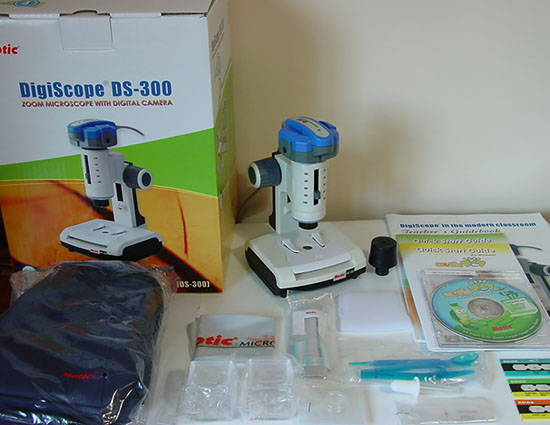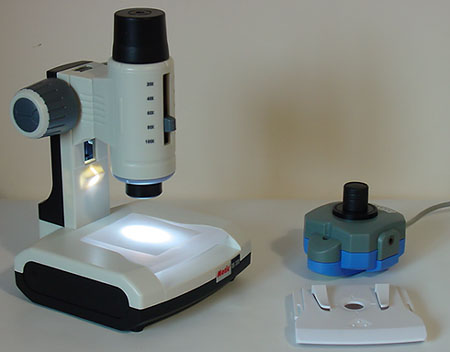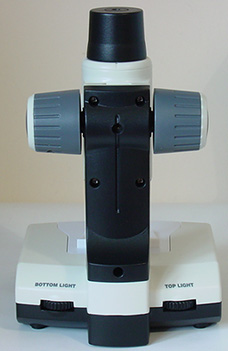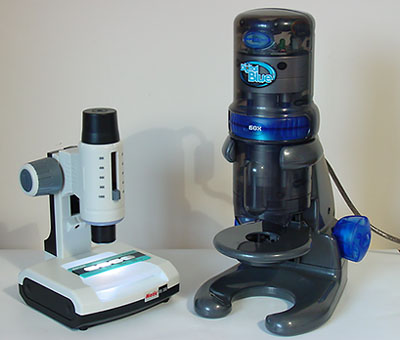
A
personal review of the Motic DigiScope 300 LED field microscope with digital camera.
Notes
on its potential for the microscopy enthusiast
by David Walker, UK
Motic's DigiScope 150 / 300 models are compact optical microscopes with built in transmitted and incident LED lighting. A USB camera is also supplied for VGA digital image capture. They are primarily marketed at the school sector but they look promising to the hobbyist seeking a field / compact microscope with the bonus of simple image capture facilities or perhaps parents looking for a more versatile microscope for their child than the excellent Digital Blue™ QX5 (reviewed in Dec. 2004). Micscape are grateful to TAG Learning Ltd who kindly arranged the DigiScope 300 model for review.
Motic are a well established microscope manufacturer and offer a wide range of microscopes from beginner to professional including a range of digital microscope cameras. The DigiScope 150 and 300 each typically sell for £110+VAT in the UK and $160 in the USA. The 150 and 300 differ in their optical magnification range, the 150 is quoted as 10x - 50x and the 300 as 20x - 100x.
Out of the box:

The microscope is attractively presented and the box includes: microscope, optical eyepiece, DS-300 digicam, two stages, calibration slide, dust cover, 'briefcase', two bugboxes with built-in lens, sample container, three prepared slides with four subjects on each, pack of simple slide making materials, pipette (bulb too rigid for little fingers), tweezers, spatula. CD-ROM with 'MoticPlay' software, 'Quick start guide' for both Mac and Windows. Comprehensive 'DigiScope in the modern classroom. Teacher's Guidebook'.
Maker's recommended computer requirements are below. Also needs USB 1.0 port to power and operate the camera.
Windows: Windows 98, ME, 2000 or XP. Pentium III or higher. Hard drive space 300MB+, RAM 128MB+. Monitor 800x600+. (The author had no problem running the camera / software on a 866MHz PIII. 256MB RAM notebook with WinXP Pro.)
Mac:
PowerPC G3+, Mac OS 9.x. Hard drive space 300MB+, RAM 128MB+.
Monitor 800x600+.


Left:
DigiScope
300 with optical eyepiece in place. The white paper on stage shows the excellent
coverage of the variable intensity top LED lighting. The translucent stage can be replaced with
the stage for prepared slides with clips and clear opening for transmitted
light. The camera dust cap also fits the optical eyepiece.
The plastic
mount on the camera unscrews to reveal a 'C' mount so could be used on a
compound / stereo microscope with suitable eyepiece tube adaptor
or
conversely an alternative lightweight 'C' mount digital camera could
be used on the DigiScope.
Right:
Rear of microscope showing the rotary switches to independently switch on
/ off and vary the intensity of the top and bottom lighting.

The
Motic DigiScope 300 next to the Digital Blue™ QX5. The DigiScope is set on the
100x mag and in focus showing the good working distance. The Motic's black
optics barrel moves independently of the white outer barrel so the direction
of focussing is not immediately intuitive (see below).
In
use: The DigiScope is compact and light but feels well made and robust. The
focussing is a substantial plastic rack and pinion with a good 'feel'.
The base houses 3xAA batteries which the maker's remark should last for 50 hours
with the LED lighting. Rotary switches on the back for each of the top and bottom
LED's switch on/off and control intensity. The focussing barrel can come off
the stand; it's tricky to use handheld even at 20x but does offer the option
of mounting on a tripod e.g. for time lapse of vertical subjects such as opening
flower buds in natural or artificial light.
Optical performance: Summary. For more details with test images, please click here.
The microscopy enthusiast may understandably be a little wary of zoom optics on a budget microscope ... as was the author, but coupled with the excellent white lighting, the images are crisp with good contrast and comparable to those from a competent student compound microscope. Image quality exceeds that of the Open University microscope which is a popular choice of hand held microscope when sourced secondhand.
The DigiScope's transmitted light is well designed as the diffuser is on the base and thus not in the object plane of focus to give a good even unstructured light source. It is still bright enough to be used at the highest mag.
The
focus takes a little getting used to as focussing is down
from 20x to 40x but up from 40x to 100x. So if moving between mags it's easy
to lose track of which direction to focus. However, there's no danger of hitting
subjects so not a problem. Focussing at high mags is doable with the simple
focus with only a little lateral flex.
Digital
camera: The 640x480 (VGA) pixel camera replaces the optical eyepiece and sits in the microscope
tube and connects to a PC and powered by a USB cable. It's a loose fit in the author's example and the cable can rotate it round
its seating and also slightly misalign it horizontally. Rotation can be useful but it could benefit from a latch and /
or clamp to hold the camera more securely. The handbook notes that it's
important to align the camera with cable pointing backwards, to ensure subject
manipulation is straightforward.
Digital image capture: There was no lag observed with the on-screen view when focusing or moving the subject. Captured images with the supplied DS-300 camera had good contrast and little noise but the VGA images had jagged edges on angled line detail. After some trials, setting the sharpening to zero from the default setting of 24 (in 0-63 range) reduced this to some extent. The cause may be a lack of anti-aliasing in the image processing software which is commonly used in consumer digicams to smooth out these so-called 'jaggies'. (See e.g. 'What are jaggies' on the 'Digicamhelp' website.) All images shown below had sharpness set to zero. Sharpening if desired is better carried out after resizing. The VGA images as with most low resolution sensors do benefit from downsampling to give a smoother result. (See note in conclusion about the upgraded sensor in the latest model.)
Software:
The 'Motic Play' software is presented in a fun and interesting way for the younger user.
The
software does not control the lighting (unlike the QX5), giving the user full
control of top and bottom lighting and intensity.
The screen shots below are of the 'Motic Play' interface.
|
The 'Edit' button leads to an 'Album' page as well as simple Editing / Paint program screen. The top right hand door symbol is the back / exit button common to all screens. The Album page contains a variety of images to view and practice editing. These images seem to have been taken with a much higher spec microscope / camera than the DigiScope, which perhaps misleads the user into what can be achieved. The 'Video Format' screen leads to an advanced sub-menu, belying the 'for the young' software presentation. The sub-menu allows parameters such as light source, colour balance, video and screen attributes, exposure method to be set.
The 'Settings' button clicks to open a sub-menu (shown right) where time lapse features can be set. Captured images can be saved as a still sequence or saved as a video as required, either 'Big' (640x480) or 'Small' (320x240). Video, both real time and time lapse, appear to be saved as uncompressed avi format, so files can be very large (ca. 10MB a second). An option to saved compressed files would be useful. Documentation: The software's on screen help is basic and aimed at youngsters. See note in conclusion about the additional software supplied in the latest model. More detailed documentation in addition to the 'Quick Start Guide' would be useful. |
|
Measurement: One of the most powerful features of the software is measurement and good to see that Motic puts a heavy emphasis on the importance of calibration and measurement in the 'Quick Start Guide'. Calibration is a cinch with the 2 mm spot slide supplied. Once calibrated, quite sophisticated measurements can be carried out on image captures using the screen shown right.
Errors of ca. 5% creep in from a single 2 mm low mag calibration (i.e. example above) when measuring at high mag but fine for many studies. There is an option to calibrate with a 200 µm spot but this is not supplied. It has to be a spot for the software to recognise it; a more versatile calibration method which allowed a line measurement would have been useful. |
Once calibrated, the right hand slider is set to the optical mag used, units are chosen, and a line drawn across a feature, in this case a record stylus, gives a read out in the bottom window. Areas can also be measured. |
TWAIN capture: The Motic software instals a TWAIN driver 'Mc300' so users just requiring a still image capture are able, as the author did, to use third party image editing software to access the live video screen, then capture and directly bring images into the editing software. The TWAIN screen shown right does not permit the powerful measurement and time lapse features of the Motic software to be used. The live screen is much smaller but focussing is still straightforward. One feature of the TWAIN 'Options' is real time vertical and horizontal 'image flip' so that the subject and image movements match. |
|
Typical images (from the pre-updated camera) The subjects below are a selection of those used in the QX5 review, the DigiScope 300 mags chosen of 30x and 90x roughly match the image capture field of view of the QX5's 60x and 200x respectively. So readers interested in both models may wish to compare. Note that the improved sensor in the latest camera should give superior images (see Conclusion.)
|
The DigiScope 300 as a field microscope With high quality optical images, good built-in lighting and a compact format, the microscope is a potentially versatile portable / field microscope. Image capture / measurement in the field is also possible with a small notebook computer. The visual field of view of ca. 1.2 - 6.2 mm overlaps that of a stereo and low to mid powers of a compound microscope so useful for many types of pond life, moss leaf study etc outdoors. Detailed studies of smaller multi-celled organisms or protozoa would require a more advanced field microscope such as the Swift FM-31 but at a much higher price. The author owns the popular Open University McArthur style field microscope which sells for about £10-20 secondhand but is no longer available new. The dual objective OU microscope has a field of view of ca. 1.8 mm and 0.77 mm so offers a slightly higher mag. than the DigiScope for smaller organisms. One fun aspect of microscopy which the DigiScope enabled was 'armchair microscopy' compared with the more formal sitting at a table. In a learning environment the microscope can be handed around for viewing a subject. Enjoying watching pond life in a covered cell slide and sharing with other family members is great fun. The author also found the DigiScope useful for just browsing through his prepared slide collection in an armchair.
Top left: The DigiScope's base sits comfortably in an adult's palm allowing focussing with the other hand while viewing down the microscope. Or the scope can readily sit on any small flat surface outside. Top and/or bottom LED variable intensity lighting is possible. A translucent stage is supplied with a cavity for water samples, but better results can be achieved with a microscope slide with well and cover slip to restrict movement and to allow transmitted illumination (as shown above). Top
right: When focussed the slide can be scanned quite well
by using the two thumbs. Control is much easier in this respect
than the reversed and linear
placing of a slide on the McArthur style microscope.
Above left: Have microscope, will travel ... The sturdy case and strap is just large enough for a small adult to use over the shoulder and has external and internal pockets e.g. for sampling accessories. Although more likely, the case would serve as protection for the 'scope when placed in e.g. a larger rucksack. Above right: The Open University McArthur style field microscope is much cheaper and smaller but in the author's view less pleasurable to use, inferior lighting and not as versatile. Field flatness in the author's example is about 50% at low power cf. the Motic's 80%+ flatfield. The OU microscope benefits from an LED retrofitted to replace the tungsten bulb. The ca. 60x and 90x settings on the DigiScope 300 correspond to the optical field of views of the low and high power setting respectively of the commonest OU microscope model. Above images by Ian Walker. |
Educational potential
The 83 page A4 teachers' guidebook supplied by Motic is well presented with 'Lesson Plans', 'Worksheets' and 'Factsheets' for a range of age groups. Subjects suggested for study included items from around the home, plants, insects and pond life. The reviewer is a microscopy hobbyist so can't specifically comment on the DigiScope's use in the classroom. See links for online reviews which cover the DigiScope's educational potential and which compare it to the IntelPlay QX3. As a microscopy enthusiast though I would say that the DigiScope's ability to show both optical and digital views makes it a more useful educational resource than the QX5 (QX3 upgrade), which although a good digital microscope at half the price, it doesn't offer to the user an optical view.
Conclusion
The DigiScope 300 is a good quality and versatile optical compact / field microscope with the bonus of VGA still / video imaging with useful measuring facilities. For potential buyers particularly interested in the digital imaging capabilities, Motic (personal communication) have kindly informed me and demonstrated that an improved camera sensor in the latest version does not show the jaggy artefact and the outfit also includes 'Motic Educator' multi-lingual software aimed at an older age group. The author's review model although obtained new in Dec. 2004 apparently predates this newer model. However, at the time of writing (Jan. 2005) from queries sent by the author to both UK and US dealers, the author was unclear of how widely available the latest version is.
For potential users specifically interested in VGA digital imaging and who already have an optical microscope, other digital imaging routes such as attaching a modified webcam or dedicated digital eyepiece to the compound microscope would be cheaper and give comparable results.
Comments to the author David Walker are welcomed.
Acknowledgements: Thank you to Rob Richardson (Regional Sales Manager) at Tag Learning Ltd for kindly arranging for the DigiScope 300 to review. Also to Julie Durnall (Customer Services / Sales) for her help. Thank you also to Motic personnel who informed the author of the improvements implemented into the latest DigiScope 300 and for showing test images from the new sensor and screenshots of the 'Motic Educator' software.
Links
- online reviews of the Motic DigiScope which include educational aspects.
1: 'Improving Science
Education 5-14' website. 'Interactive
Primary Newsletter 28'.
2: CLEAPSS
School Science Service website. 'A new digital microscope: The Motic Digiscope 300'.
Published in the February 2005 edition of Micscape.
Please report any Web problems or offer general comments to the Micscape Editor .
Micscape is the on-line monthly magazine of the Microscopy UK web site at Microscopy-UK
© Onview.net Ltd, Microscopy-UK, and all contributors 1995
onwards. All rights reserved.
Main site is
at www.microscopy-uk.org.uk
with full mirror
at www.microscopy-uk.net
.